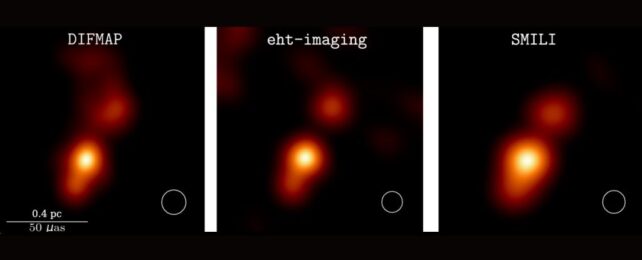The global collaboration that delivered us not one but two pictures of supermassive black holes has now peered into one of the brightest lights in the Universe.
The Event Horizon Telescope (EHT), a telescope array comprising radio antennae around the world, studied a distant quasar named NRAO 530, whose light has traveled for 7.5 billion years to reach us.
The resulting data show us the quasar's engine in incredible detail and will, astronomers say, help us understand the complex physics of these incredible objects, and how they generate such blazing light.
Quasars – a term that's short for "quasi-stellar radio sources" – are a type of galaxy thought to be powered by a very active supermassive black hole at the center. That means that the black hole is surrounded by material that is falling onto it at a furious rate.
Black holes themselves emit no light, but the material around an active black hole does. Gravity and friction cause the material to heat up and blaze as it circles the black hole like water down a drain. But that's not all.
Not all the material falls onto the black hole. Some of it is funneled and accelerated along magnetic field lines just outside the event horizon – the "point of no return", beyond which not even light can reach escape velocity.
When this material reaches the poles, it is launched into space as powerful jets of plasma, traveling at speeds a significant percentage of the speed of light, referred to as relativistic speed. These thin collimated jets also shine brightly… but we don't fully understand how they are created and powered, and the role played by magnetic fields.
Enter the EHT. It's not one individual instrument or array, but a collaboration of radio telescope facilities around the world that combine to effectively form an Earth-sized radio telescope, kind of like an astronomy Voltron.
This telescope is a powerful thing. In 2019, it gave humanity our first ever image of the event horizon of a black hole, the heart of a galaxy named M87 55 million light-years away. Then, last year, it delivered an image of the supermassive black hole at the center of our own Milky Way galaxy, Sagittarius A*.
Both images were years in the making. The observations of NRAO 530 actually took place in April 2017; the international team used it as a calibration target for taking images of Sgr A*. This quasar is a popular calibration target for the center of the Milky Way, since the two objects appear pretty close together in the sky.
It's those observations that a team – led by astronomers Svetlana Jorstad of Boston University and Maciek Wielgus of the Max Planck Institute for Radio Astronomy in Germany – have now used to peer into the heart of NRAO 530. Across such a vast distance in time and space, the researchers were able to see the heart of the quasar in unprecedented detail.
"The light that we see traveled towards the Earth for 7.5 billion years through the expanding Universe, but with the power of the EHT we see the details of the source structure on a scale as small as a single light-year," explains Wielgus.
NRAO 530 is a rare type of quasar known as an "optically violent variable" quasar, and is known to have a powerful, highly relativistic jet. It's also categorized as a blazar; that's a blazar that's oriented in such a way that the jet is pointed directly or almost directly at us.
Blazars pose no danger, but can be quite challenging to study, like peering down a linear laser beam.
The EHT images show a bright feature at the southern end of the jet; the researchers believe that this is the radio "core", the point at which the jet is launched at a specific wavelength of light. This core has two components, which can't be seen at longer wavelengths of light, but are clearly visible in the EHT observations.
From their observations, the team was able to determine the polarization of the light emitted from different parts of the structure. This refers to the orientation of the oscillations of the light, which can be affected by magnetic fields that it travels through.
This allowed the team to map the magnetic fields in the jet, finding evidence that the magnetic field has a helical structure.
"The outermost feature has a particularly high degree of linear polarization, suggestive of a very well ordered magnetic field," Jorstad says.
To date, NRAO 530 is the most distant object the EHT has studied, and the results show promise for future studies of distant objects, as well as more detailed studies of blazars and quasars.
The research has been published in The Astrophysical Journal.
